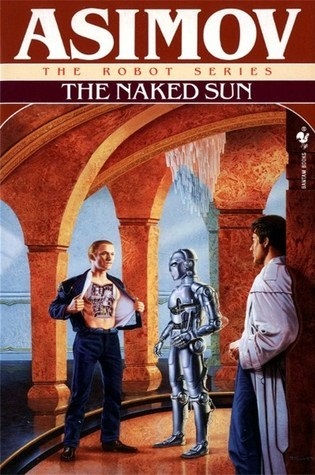- The Good: Unique combination of the mystery and scifi genres
- The Bad: Whodunnit detective narrative is good but not great
- The Literary: Highly effective worldbuilding
Rikaine Delmarre is found dead in his home, but the only other person to physically ever see him was his wife, and only on planned visitation days. Because of their success in solving the murder of a Spacer in Caves of Steel, Detective Elijah Baley of New York City and robot R. Daneel Olivaw of Aurora are hired to solve the mystery of the murder. Either the Solarian was killed by one of his robots—unthinkable under the laws of Robotics—or he was killed by the woman who loved him so much that she never came into his presence.
Three millennia in the future, New York City police detective Elijah Baley is like most other Earthers, afraid of open air, having lived below ground in caves of steel alongside all other people on Earth. But on the beautiful Outer World of Solaria, a handful of human colonists live on the surface, and they almost never interact with other humans, a lifestyle possible because of the multitudes of robot servants.
I love the worldbuilding of the Solarian civilization, especially in contrast with Earth. Baley can barely think of seeing the sky without hyperventilating, because Earthers live all crammed together in a claustrophile’s dream under the Earth’s surface. But Solarian’s are so thinly populated that they have simply evolved away from requiring personal contact. Birthing and children are taboo topics in polite conversation, as population replacement is only achieved through artificial insemination. Child rearing is left to robots, and communication is strictly through holographic imagery.
I haven’t read much classic mystery, but this one is better than its predecessor, with a compelling new take on the impossible “locked room” scenario, which requires understanding the differences and implications of three new cultures—Earth, Solaria, and robots. Baley is less emotional in this sequel, seeming to emulate the serious and dispassionate natures of other famous detectives. I especially enjoy the final reveal of the murder and the weapon that takes place in a cozy drawing room, with all the possible suspects in attendance, albeit virtually.
Much of the novel is made possible by the absence of robot Daneel Olivaw, which ends up working fine, though his character is growing on me. Daneel’s attempts to protect Baley from overexposure to the outside hinders Baley’s investigation, so Baley attempts to hold up Daneel using some good old-fashioned robot logic. As with all the Robot novels, this one hinges on the three fundamental laws of Robotics.
Baley does have some sexual tension with a leading female character in the book, which reads uncomfortably to my modern eyes, seeing that Baley is happily married, his wife back on Earth. The romance is played straight and innocent though, so I guess it’s okay?
The novel culminates in a final chapter that waxes quite poetic about the nature of humanity and the future of the human race. It’s quite moving and philosophical and a nice serious touch after the whimsy of the mystery.
Highly recommended for all lovers of science fiction, classic or contemporary! For mystery lovers, try this one before Caves of Steel.
